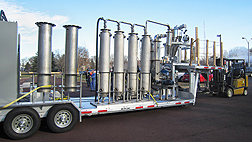New—and More Economical—Pyrolysis Techniques for Bio-oil Production
|
|
Fast pyrolysis, the process of rapidly heating biomass without oxygen, produces energy-dense bio-oil from wood, plants, and other carbon-based materials.
“It’s becoming one of the most promising methods for extracting the energy from tough plant materials to produce liquid fuels,” says Agricultural Research Service chemist Charles Mullen. Now, innovations by Mullen and his ARS colleagues are bringing researchers one step closer to using pyrolysis in production systems that farmers can use to meet their on-farm energy needs—or to produce renewable fuels for commercial markets.
Using pyrolysis to break down tough feedstocks produces three things: biochar, a gas, and bio-oils that are refined to make “green” gasoline. The oils are high in oxygen, making them acidic and unstable, but the oxygen can be removed by adding catalysts during pyrolysis. Although this adds to production costs and complicates the process, the resulting bio-oil is more suitable for use in existing energy infrastructure systems as a “drop-in” transportation fuel that can used as a substitute for conventional fuels.
In 2013, Mullen and two other researchers—lead scientist Akwasi Boateng and mechanical engineer Neil Goldberg—filed a patent application for a new pyrolysis process that removes much of the oxygen from bio-oils without the need for added catalysts. The three scientists work at the ARS Eastern Regional Research Center in Wyndmoor, Pennsylvania, in the Sustainable Biofuels and Coproducts Research Unit.
The team conducted a pilot-scale study using three types of biofeedstock with different characteristics: oak, switchgrass, and pressed pennycress seeds. They modified standard pyrolysis by gradually replacing nitrogen gas in the processing chamber with recycled gases produced during pyrolysis until they found the best mix to yield the desired products. Compared to the standard pyrolysis process of using nitrogen gas, which did not affect oxygen levels, using recycled gases derived from biomass was overy effective in lowering oxygen levels and acidity. With the right mixture, no additional catalysts were needed.
The bio-oils produced from oak and switchgrass by the new process had considerably higher energy content than those produced by conventional fast pyrolysis. The energy content of the oak bio-oil was 33.3 percent higher, increasing from 23.7 to 31.2 megajoules per kilogram, so it contained about two-thirds of the energy contained in gasoline. The energy content for switchgrass was 42 percent higher, increasing from 23.4 to 33.2 megajoules per kilogram—slightly less than three-fourths of the energy content of gasoline. The energy content in bio-oil produced from pressed pennycress seed feedstock did not show a similar increase.
The researchers published the results in 2013 in Energy Fuels. A grant of $6.8 million from USDA’s National Institute of Food and Agriculture, recently awarded to an ARS-industry-university consortium led by Boateng, will ensure that he, Mullen, and the rest of the team will be able to continue work on improving pyrolysis techniques for producing bio-oil and high-value specialty chemicals. The work funded by the grant will include the generation of a complete bio-oil production life-cycle assessment, from environmentally sustainable biomass collection and handling to the final process of biofuel production.—By Ann Perry, Agricultural Research Service Information Staff.
This research is part of Biorefining (#213) and Agricultural and Industrial Byproducts (#214), two ARS national programs described at www.nps.ars.usda.gov.
Charles Mullen is with the USDA-ARS Eastern Regional Research Center, 600 E. Mermaid Lane, Wyndmoor, PA 19038-8598; (215) 836-6916.
"New—and More Economical—Pyrolysis Techniques for Bio-oil Production" was published in the April 2014 issue of Agricultural Research magazine.







